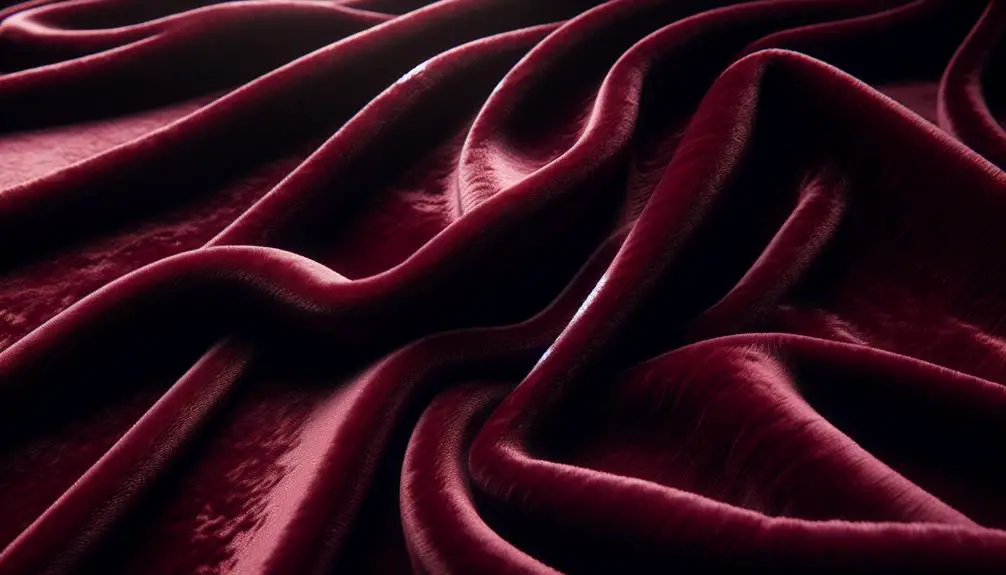Have you ever wondered why we call that soft, luxurious fabric "velvet"? It's interesting because the name actually comes from the Latin word "villosus," meaning hairy, which is a nod to its fuzzy texture. But there's more to it than just texture. Velvet has a deep history that intertwines with royalty and opulence, making its way through various cultures and epochs. I've always found it fascinating how a single word can carry such a rich backstory. If you're curious about how velvet evolved from ancient times to become a modern luxury, stick around—you might find the journey quite intriguing.
Table of Contents
Key Takeaways
- The term "velvet" originates from the Old French "veluet," indicating its European adaptation.
- It is derived from the Latin word "villosus," meaning "hairy," reflecting its textured surface.
- The name relates to the fabric's soft, dense pile that resembles fur.
- Historical linguistics show the evolution of the term through cultural exchanges in textile semantics.
- "Velvet" captures the essence of the fabric's luxurious and plush characteristics.
Origins of the Name "Velvet"
The name 'velvet' traces back to the Latin word 'villosus', meaning shaggy or tufted. It's fascinating how this luxurious fabric got its name from a word that conjures images of something quite unruly! This gives us a hint about velvet's distinctive texture. When you dive deep into velvet etymology, you start to see a pattern of how textiles are often named for their physical characteristics.
Looking into name origins, 'velvet' underwent a transformation as it moved through different cultures. It didn't just pop up in the fashion world with its modern moniker. The term evolved, picking up nuances in languages as it traveled across continents. This journey shaped the semantics, enriching the fabric's history and giving it a storied past that adds to its allure today.
Understanding why we call it 'velvet' isn't just about linguistic curiosity; it's about appreciating the narrative stitched into every piece made from it. Each time you touch velvet, you're literally feeling centuries of linguistic and cultural history. Isn't it amazing how a single word can encapsulate so much depth? That's the power of names in the world of textiles.
Etymology and Language Connections
Exploring how 'velvet' evolved across languages highlights the intricate links between etymology and cultural exchanges. The term itself has traveled through a fascinating linguistic journey, reflecting not just a fabric but also the interweaving of cultures.
Let's immerse ourselves in the velvet linguistics. The English word 'velvet' traces back to the Old French 'veluet,' a diminutive of 'velu,' meaning shaggy or hairy. This French term is rooted in the Latin 'villosus,' or 'hairy.' It's not just a description of the fabric's texture but hints at its luxurious feel and appearance, which appealed universally.
But there's more to the story. The shift from Latin to French and into English showcases how fabric semantics evolve in response to cultural values and trade dynamics. Each linguistic adaptation encapsulates a historical exchange of ideas, aesthetics, and technology.
Understanding these shifts gives us more than just a history lesson; it deepens our appreciation of velvet in today's fashion and design. Knowing the origins and transformations of the word 'velvet' enriches our understanding of its significance as more than just a fabric but a cultural artifact. This exploration into the etymology is truly about connecting threads—both literal and metaphorical—across time and cultures.
Historical Production of Velvet
Now, let's talk about how velvet was made way back when.
It all started in the East, where they knew a thing or two about crafting this lush fabric.
Then, as it caught on, medieval Europeans developed their own special techniques to make it.
Origins in Eastern Cultures
Velvet's rich history first unfolded in the ancient cultures of China and Egypt. This luxurious fabric was once a symbol of power, worn by Eastern royalty and traded extensively along the Silk Road. It's fascinating how this material became a cultural icon, reflecting both wealth and artistic innovation in ancient societies.
To keep you hooked, here's a quick rundown:
- Ancient China: Birthplace of silk velvet, influencing global textile art.
- Egyptian Influence: Techniques and styles that captivated traders.
- Silk Road Trade: The major highway for velvet's journey to prominence.
- Eastern Royalty: The elite's choice for opulence and grandeur.
Delving into these roots, you'll see why velvet's more than just fabric; it's a historical tapestry woven through time.
Medieval European Techniques
As we explore the Medieval period, European artisans elevated velvet production to new heights with innovative techniques. They didn't just weave; they mastered the art. The European weaving guilds played a huge role in this. These guilds were tight-knit communities where secrets of the craft were closely guarded and passed down through generations. They constantly refined their methods, ensuring only the highest quality velvet made it to market.
They also excelled in medieval dyeing methods, using rich, vibrant colors that were rare at the time. This wasn't just about making fabric; it was about creating a luxury item that symbolized status and wealth. The combination of sophisticated weaving techniques and advanced dyeing made European velvet highly sought after across continents.
Velvet's Journey Through Europe
Velvet embarked on its journey across Europe, establishing itself as a symbol of luxury and wealth in various cultures. As I delve into its history, it's evident that the fabric's expansion was greatly influenced by European trade routes and the flourishing of the Renaissance, which elevated its status and broadened its appeal.
Here are a few pivotal moments in velvet's European journey:
- Spread via Trade Routes: Velvet production began to flourish as European trade routes expanded, connecting the East and the West. This integration brought velvet to new markets where it was enthusiastically embraced by the wealthy.
- Renaissance Influence: The Renaissance period, with its focus on art and aesthetics, propelled velvet into the spotlight as a material that denoted status and taste.
- Royal Patronage: Kings and queens across Europe adorned their palaces and themselves in velvet, further solidifying its association with wealth and power.
- Artistic Depictions: Prominent painters of the time often portrayed velvet in their artworks, which helped disseminate its image as a luxurious fabric.
Understanding velvet's journey through Europe isn't just about tracing a fabric; it's about seeing how deeply a material can intertwine itself into the cultural and economic tapestry of a continent.
Cultural Significance in Fashion
Exploring the cultural significance of velvet in fashion reveals its deep impact on style and social status. Velvet's been a big deal for ages, and not just because it looks lush. It's packed with symbolism. For centuries, wearing velvet was like shouting from the rooftops that you'd made it big. It was the fabric of kings, queens, and anyone who was anyone in society.
Velvet symbolism doesn't stop at wealth and power, though. In many cultures, different colors of velvet also had meanings. Red velvet often symbolized passion and nobility, while black velvet could denote solemnity or authority. This rich fabric became a key player in many traditional ceremonies. Think about the robes of a judge or the gowns at a coronation. Velvet wasn't just a choice; it was a statement.
Now, let's talk velvet ceremonies. From royal events to religious rituals, velvet has always been front and center. It's not just about the visual appeal; the fabric's texture and sheen convey a sense of gravity and significance that few materials can match. So, when you see velvet at a ceremony, it's not just decor—it's a deep-seated cultural emblem.
Velvet in Art and Literature
One can't overlook velvet's vivid portrayal in art and literature, where it often symbolizes complexity and depth. This fabric isn't just about luxury; it's layered with meaning, often representing power, wealth, or mystery. In many artworks and literary pieces, velvet motifs serve as a backdrop that enriches the narrative or visual aesthetic.
Here's how velvet has been used to captivate and convey deeper meanings:
- In Renaissance paintings, velvet robes symbolized nobility and status, adding a tactile depth to the visual storytelling.
- Shakespeare's plays often referenced velvet to denote status or character traits, using the fabric's connotations to deepen audience understanding of a character's social standing or personality.
- Gothic literature uses velvet draperies and garments to create a sense of brooding opulence and foreboding, enhancing the atmospheric tension.
- Modern photography employs velvet backgrounds to evoke a sense of the past, utilizing its texture and richness to add a layer of nostalgia and depth.
Velvet symbolism in art and literature isn't just decorative; it's a deliberate choice that adds layers of meaning, enhancing the narrative or artistic expression. As a fabric, velvet goes beyond the tactile; it weaves its own stories and histories into the cultural fabric.
Technological Advances in Velvet Making
Recent advancements have dramatically transformed how we produce velvet, making the process faster and more efficient. I've noticed that newer technologies not only speed up production but also focus heavily on reducing the environmental impact. It's become essential to adopt methods that minimize waste and energy use.
For instance, the integration of automated systems in velvet manufacturing has slashed the amount of fabric waste produced. These systems precisely control fabric cutting, ensuring that materials are utilized to their maximum potential. I find this not only boosts efficiency but also aligns with the growing consumer trend towards sustainability.
Moreover, water usage and dyeing processes have been re-engineered. Advanced dyeing technology uses less water and more environmentally friendly dyes. This is a big deal because traditional dyeing used tons of water and often released harmful chemicals into our ecosystems. Now, it's all about reducing those negative outputs.
Consumers today are increasingly aware of the environmental impacts of their purchases. They're demanding products made sustainably, and the velvet industry is responding. It's fascinating to see how these technological changes aren't just about keeping up with manufacturing demands but also about meeting consumer expectations for sustainability. This shift is reshaping how we think about and produce velvet.
Variations and Types of Velvet
Now, let's talk about the different kinds of velvet out there.
We've got traditional fabrics that have been around for ages, some cool new innovations, and even special ways to keep them looking great.
I'll walk you through each type so you can get a real sense of what's what.
Traditional Velvet Fabrics
Traditional velvet fabrics come in various types, each with its unique texture and appearance. When you're diving into velvet weaves comparison, it's important to see how each type stands out:
- Silk Velvet: Luxurious and soft, often used in high-end fashion.
- Cotton Velvet: Less shiny than silk, but highly durable and perfect for upholstery.
- Crushed Velvet: Created by pressing the fabric while wet, leading to a lustrous, textured surface.
- Velveteen: A cotton imitation that's more affordable but still offers a similar plush feel.
Staying on top of velvet color trends is essential too. They can dramatically influence the aesthetic and demand for each velvet type. It's all about matching the right type with the current trend.
Modern Velvet Innovations
Velvet's evolution hasn't slowed, introducing cutting-edge variations like micro velvet and embossed velvet that cater to modern tastes and functionalities. These new types aren't just about looks; they're also stepping up in sustainability.
Let's talk velvet recycling. It's becoming a big deal. Manufacturers are now finding ways to reclaim and reuse velvet materials, reducing waste and environmental impact. Then there's biodegradable velvet. This stuff is designed to break down more quickly once disposed of, lessening its footprint on our planet.
As you dive into these innovations, you'll see that velvet's not just for royalty anymore. It's for anyone interested in style and sustainability. It's exciting to see how this classic fabric is adapting, isn't it?
Velvet Care Techniques
Caring for different types of velvet requires specific techniques to keep them looking their best. Whether you're dealing with crushed velvet or a delicate silk blend, here's how you can master the care game:
- Stain Removal: Blot spills immediately with a clean, dry cloth. Avoid rubbing as it can damage the fabric's pile.
- Gentle Cleaning: Use a soft brush to dust off any surface dirt. For deeper cleaning, steam lightly, never letting the iron touch the fabric.
- Proper Storage: Hang velvet garments on padded hangers to avoid creases and maintain their shape.
- Avoid Moisture: Keep velvet away from damp areas to prevent mold and maintain its luxe texture.
Modern Uses of Velvet
Today, velvet is everywhere, from luxurious couches to trendy clothing lines. It's easy to see why. Velvet adds a touch of elegance and comfort that few materials can match. Let's explore how velvet is shaping up in modern décor and fashion.
In the world of home décor, velvet upholstery trends are hard to miss. People are choosing velvet for their furniture more than ever before. It's not just about sofas and armchairs either. You'll find velvet in unexpected places like dining chairs and headboards. The reason? Velvet brings a rich texture and depth that enhances any space.
But it's not all about looks. Sustainability is key in today's world, and velvet is stepping up. Velvet recycling methods are improving. Fabric scraps from production and old velvet goods don't have to end up in landfills anymore. Companies are finding innovative ways to repurpose these into new products. This approach not only reduces waste but also appeals to eco-conscious consumers.
In fashion, velvet continues to reign. Designers are using it for everything from blazers to boots, showing its versatility. Whether in a classic black gown or a bold, patterned jacket, velvet has a unique way of making any outfit stand out.
The Future of Velvet in Textiles
Looking ahead, the future of velvet in textiles seems poised for innovative transformations. As we dive deeper into sustainable practices, the spotlight shines on reducing the environmental impact and enhancing recycling methods for velvet production. Here's what's brewing:
- Bio-based Materials: Researchers are exploring plant-based sources to create velvet that's both luxurious and kinder to our planet.
- Recycling Breakthroughs: New technologies are emerging that could allow for old velvet to be efficiently recycled, reducing waste and resource consumption.
- Waterless Dyeing Processes: This method aims to cut down on the massive amounts of water traditionally used in dyeing velvet, drastically lowering its ecological footprint.
- Local Manufacturing Push: By focusing on local production, we reduce transportation emissions and support local economies.
I'm particularly excited about the potential of these innovations. They don't just promise to keep velvet in our wardrobes; they aim to do so in a way that respects our environment. It's about making sure that our love for velvet doesn't cost the earth. The journey towards sustainable velvet isn't just necessary; it's inspiring. Let's keep pushing the boundaries and setting new benchmarks in the textile industry.
Frequently Asked Questions
Can Velvet Fabric Cause Allergic Reactions?
Yes, velvet can cause allergic reactions if you're sensitive to certain fabrics. It's not common, but the texture and chemicals used in production might be allergy triggers for some people.
How Do You Remove Stains From Velvet Upholstery?
To remove stains from velvet upholstery, I start with stain identification, then apply specific cleaning techniques. I use gentle cleaners and soft cloths, dabbing not rubbing, to avoid damaging the delicate fabric.
Is Velvet Suitable for Summer Clothing?
Velvet's breathability isn't great, so it's not ideal for summer clothing. I'd choose lighter fabrics to stay cool. Stick to velvet for winter to master those cozy, stylish looks!
What Is the Environmental Impact of Producing Velvet?
Producing velvet has a significant environmental impact. It uses lots of water and releases chemical pollutants. I'm learning it's not the most eco-friendly fabric, which really makes me rethink my fashion choices.
Are There Vegan Alternatives to Traditional Velvet?
Yes, there are vegan alternatives to traditional velvet. Synthetic alternatives, like polyester and microfiber, mimic velvet's texture but don't involve animal products, making them ideal for sustainable velvet production.
- How Does Ring Spun Cotton Affect Garment Fit and Shape Retention? - August 13, 2024
- What Are the Challenges in Producing Ring Spun Cotton? - August 13, 2024
- Is Ring Spun Cotton Suitable for Plus-Size Clothing? - August 13, 2024







